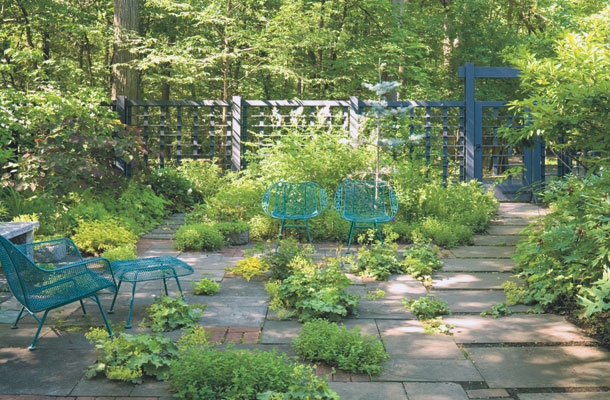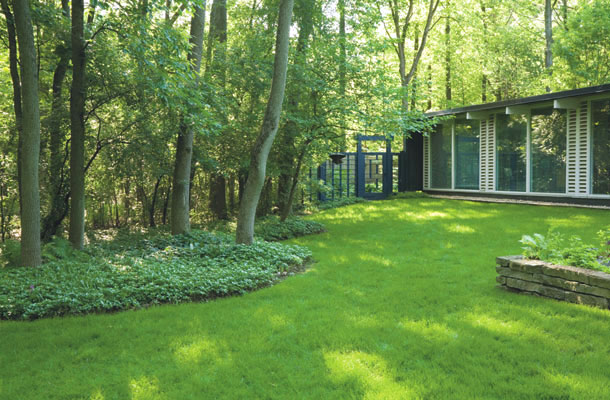In 1986, before mid-century modern houses caught on as hipsters’ dream homes, Joan and Gary Gand bought a nice, comfortable place in Chicago’s northern suburbs. Low-slung and somewhat boxy, the house had rows of large windows that gave it an appealingly open feel.
Pretty soon, the couple realized what it meant to be living in a Keck and Keck home. Brothers George Fred Keck and William Keck, who were among Chicago’s leading residential architects during the heyday of modernism from the 1940s through the 1960s, used simple rectilinear layouts and great expanses of window glass, along with narrow louvered panels for natural ventilation, as part of their vision of a modest and well-ordered postwar residence. Catching on, the Gands started collecting period-appropriate furniture, glassware, and art, until the inside of the house looked as if it hadn’t changed since 1955, when the first owners lived there.
When the Gands moved in, the serene two-acre yard that surrounded the house sported a basic carpet of grass, punctuated here and there by tall trees and planter boxes. The manicured lawn didn’t fit with the home’s woodsy surroundings-and the big, broad windows showcased the incongruity. "This house had been designed to bring nature in," says Gary, president of the Gand Music & Sound store in Northfield, "but there wasn’t really any nature out there."
But since they made the decision to rip out the front lawn and start a shade garden, the Gands have been able to surround their home with garden spaces that smartly complement the Keck architecture.
Like the house itself, the gardens are tidily arranged. The front yard holds an inviting array of shade-flowering perennials; walkways wind through and around them. The large side yard features a charming patio broken up by exuberant plantings that are encouraged to grow between the paving stones; the mellow space is fenced to keep deer out. And in the back yard, with its lush lawn in areas prone to spring flooding, strong shrubs and ornamental grasses outside the oversized windows emphasize the interface between indoors and out.
Photography: Alan Shortall
 |
|
Lady’s mantle, columbine, Veronica, and other perennials bloom from the crannies between paving stones on the patio, whose fence protects delicate plants from grazing deer. The fence also identifies this side yard as an intentional garden, a pleasant refuge, instead of the afterthought that side yards tend to become. ::: View Photo Gallery |
Like their indoor collections of pottery and art, the Gands’ garden is an ode to the mid-century period. It doesn’t have the tight foundation plantings, perfect rosebushes, and sprawling rectangular lawn you might expect, but the garden’s natural style embodies a popular look in modernist gardens. The landscape reflects the Kecks’ attitude toward the house-an informal approach to living, an appreciation for natural materials, an embrace of simplicity.
"One of the principles of modernism [in residential architecture] is blurring the boundary between indoor and outdoor," says Joan, co-founder of Chicago Bauhaus and Beyond, a nonprofit organization of fans of that period’s architecture. "There are two types of modernist-style gardens. There’s the geometric garden that extends the architectural forms in the house to the outdoors. And there’s our style. It’s more casual and natural, where you bring nature right up to the house."
The choice was apt, given the abundance of nature that surrounds them in their leafy neighborhood, but it has also maximized their enjoyment of the warm seasons. The patio, for instance, lies directly outside the home office the Gands share. "If you’re looking out there and see some weeds or something that needs to be pruned, you just step outside and get it done," Gary says. "Instead of saying, ‘Now I should go out to the garden,’ it’s tugging you out there all the time." The problem then is going back inside-who would want to when the patio is adrift in the chartreuse clouds of lady’s mantle in bloom? So they take their work outside.
Whether it’s flooded or dry, the back lawn is primarily something to be crossed-by the eye looking out toward the forest margin at the edge of the yard, or by someone headed to the fanciful treehouse set farther off from the house.
Strong enough to hold 20 people and accessed via a sturdy ladder, the treehouse was built in 2001 to replace the rickety remains of an older, kid-style tree fort. Gary used to like to sit atop the old platform in a folding chair, "just to get that bird’s-eye view," he says. While perched up there, he noticed an unexpected benefit: mosquitoes, numerous in this marshy locale, don’t appear to like flying up that high.
So when the time came to build "a big piece of hardscape as an anchor in the back yard," Joan says, a treehouse for grownups easily won out over a gazebo or a teahouse, which friends were suggesting. "That all seemed too clichéd," she says. "This would be kind of our gazebo, but up in the trees." And to date, not a single mosquito has found its way up there.
photography: Alan Shortall



